Survivors 229 Summary Aircraft hijacking Date December 24, 1994 Crew count 12 | Role Plane crash Operator Air France Name Air Flight | |
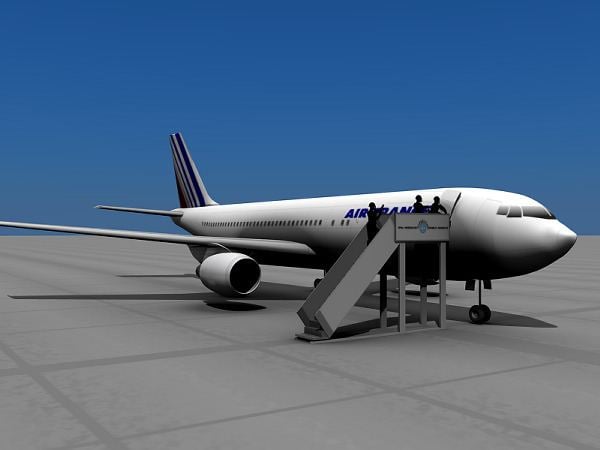 | ||
Site Houari Boumedienne AirportAlgiers, Algeriathen Marseille Provence AirportMarseille, France43°26′23″N 5°12′54″E / 43.43972°N 5.21500°E / 43.43972; 5.21500Coordinates: 43°26′23″N 5°12′54″E / 43.43972°N 5.21500°E / 43.43972; 5.21500 Passengers 220 (excluding all 4 hijackers) Injuries (non-fatal) 25 (13 passengers, 3 crew, 9 GIGN) Fatalities 7 (3 passengers, all 4 hijackers) Aircraft type Airbus A300B2-1C (c/n 104) Similar Singapore Airlines Flight 117, British Airways Flight 5390, Air France Flight 358, Atlantic Southeast Airlines Fl, American Airlines Flight 965 | ||
Air France Flight 8969 Hijacking and GIGN raid
Air France Flight 8969 was an Air France flight that was hijacked on 24 December 1994 by the Armed Islamic Group (GIA) at Houari Boumedienne Airport, Algiers, Algeria, where the terrorists murdered three passengers, with the intention to blow up the plane over the Eiffel Tower in Paris. When the aircraft reached Marseille, the GIGN, a counter-terror unit of the French National Gendarmerie, stormed the plane and killed all four hijackers.
Contents
- Air France Flight 8969 Hijacking and GIGN raid
- levelat350 gets taken away in N6272D
- Background
- 24 December
- 25 December
- 26 December
- Raid
- Aftermath
- Passengers and crew
- Hijackers
- Dramatization
- References
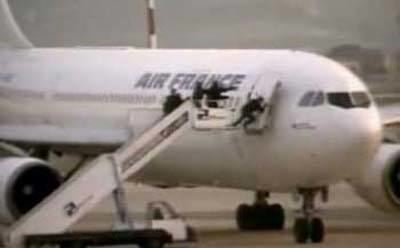
levelat350 gets taken away in N6272D
Background
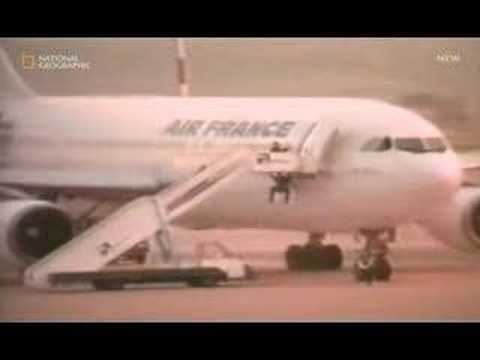
Algeria was in a state of civil war at the time of the hijacking. Aircraft flying to Algiers faced the possibility of missile attacks. As a result, Air France's flights to Algiers had crews entirely made of people who volunteered for the route. Air France had asked government officials if it absolutely had to continue flying to Algeria; as of the time of the hijacking, there had been no replies. Bernard Dhellemme was the captain of the flight. Jean-Paul Borderie was the copilot, and Alain Bossuat was the flight engineer. The Airbus A300B2-1C, tail number F-GBEC, had first flown on 28 February 1980.
24 December

On 24 December 1994, at Houari Boumedienne Airport, Algiers, Algeria, four armed men dressed as Algerian presidential police boarded Air France Flight 8969 bound to depart for Orly Airport, Paris at 11:15 am. The men had blue uniforms with Air Algérie logos. Their presence originally did not cause alarm. Two of them began inspecting the passengers' passports while one went into the cockpit and the fourth stood guard. Claude Burgniard, a flight attendant, recalled noticing that the "police" were armed and one hijacker had dynamite showing; she considered this as unusual as the Algerian police were not usually armed while performing checks. The Algerian military felt suspicion when it noticed that the Air France flight had what appeared to be an unauthorised delay, so members began surrounding the aircraft. Zahida Kakachi, a passenger, recalled seeing a group of Algerian special forces, known as "ninjas," outside the aircraft. Kakachi recalled hearing one of the "police" say "taghut," an Arabic word for "infidel", upon seeing the "ninjas" gathering outside the A300; therefore, she discovered that they were terrorists. The four men revealed then that they were not police, but mujahideen seeking to establish an Islamic state in Algeria. The men hijacked the aircraft because, as a part of the national airline Air France, it was a symbol of France, which they viewed as infidel foreign invaders.

The leader, Abdul Abdullah Yahia, already a notorious murderer, and the other three members of the Armed Islamic Group (Groupe Islamique Armé, or GIA) brandished firearms and explosives and announced their allegiance to the Armed Islamic Group, demanding co-operation from the 220 passengers and 12 flight crew. The hijackers had Kalashnikov assault rifles, Uzi submachine guns, pistols, homemade hand grenades, and two 10-stick dynamite packs. At one point in the flight, the men placed one pack of dynamite in the cockpit and one pack under a seat in the middle of the aircraft. The men linked them with detonator wire. They also took the uniforms of the pilots to confuse Algerian army snipers.
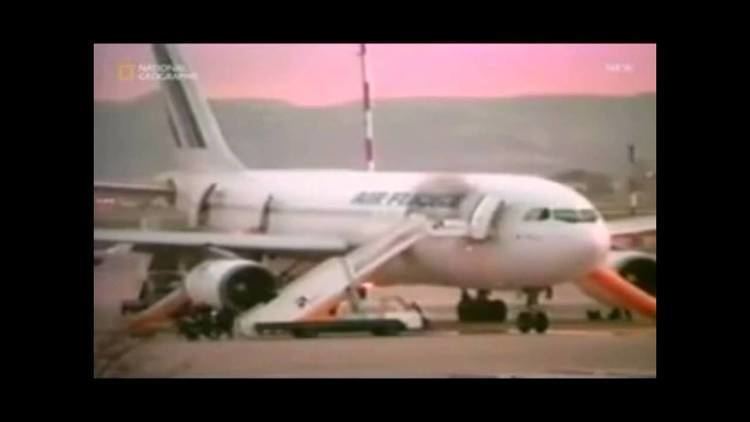
Allah has chosen us to die and Allah has chosen you to die with us. Allah guarantees our success, Insha'Allah.
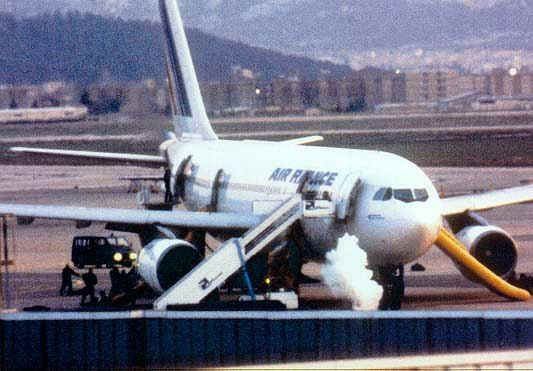
Burgniard recalled that the hijackers, mostly Lotfi, did not like seeing a lack of adherence to their Islamic beliefs; according to Burgniard, the hijackers objected to men and women sitting together and sharing the same toilets and women having uncovered heads. Once they took control of the aircraft, the hijackers forced women with uncovered heads, including the cabin crew members, to cover their heads. Women who did not have veils used aircraft blankets to cover their heads. An elderly Algerian man told the TF1 network that the hijackers "had a kind of art in their terror. Twenty minutes of relaxation and twenty minutes of torture. You never knew what was next."
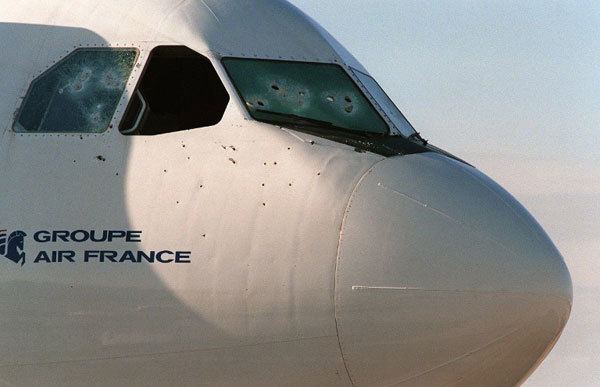
The men stated over the aircraft's cockpit radio:
We are the Soldiers of Mercy. Allah has selected us as his soldiers. We are here to wage war in his name.
Abderrahmane Meziane Chérif, the Minister of the Interior of Algeria, came to the airport control tower to begin negotiating with the hijackers. The hijackers, using the captain to speak for them, demanded the release of two Islamic Salvation Front (FIS) political party leaders, Abassi Madani and Ali Belhadj, who were in house arrest; the FIS was banned in Algeria in 1992. Chérif demanded that the hijackers begin releasing children and elderly if they wanted to talk to the Algerian government. The media began arriving at the airport to cover the crisis.
At 12 noon, French Minister of Foreign Affairs Alain Juppé organised a crisis team, and Charles Pasqua, Interior Minister of France, met his aides. French Prime Minister Édouard Balladur was recalled from his Christmas vacation in Chamonix, France, and other government officials were recalled from their vacations. Balladur recalled spending his entire afternoon on the telephone, trying to determine what was happening and feeling confusion. According to Balladur, the Algerian authorities wanted to crack down on the terrorists and that Balladur encountered difficulties discussing the events. At one point, the hijackers dropped the demand for the release of the party leaders. Two hours after the hijacking began, the hijackers asked the captain to depart for Paris so the hijackers could hold a press conference there. The captain could not take off as the aircraft boarding stairs were still attached to the A300 and the Algerian authorities blocked the runway with parked vehicles. When the captain, forced by the hijackers, asked for the removal of the boarding stairs, the Algerian authorities, determined not to give in to any of the hijacker demands, refused. The hijackers announced that they would detonate the aircraft unless the Algerian authorities gave in to the demands.
During the passport check, the hijackers had discovered that an Algerian police officer was a passenger on the flight. To get the Algerian government to cave in, the hijackers came to the police officer and asked him to follow them. Kakachi recalled that the police officer, two rows behind her, was hesitant to follow the hijackers as he did not know what was going to happen. Several passengers recalled him pleading "Don't kill me, I have a wife and child!" The hijackers shot the police officer in the head on the top of the boarding stairs. The pilots and most of the passengers initially did not know that the Algerian police officer had been killed. Dhellemme recalled that his first contact with the passenger cabin during the hijacking was when a flight attendant, allowed into the cockpit, asked the pilots if they needed anything. According to Dhellemme, he asked for a glass of water from the attendant as the pilots' throats were parched and the pilots had difficulty swallowing. The attendant then whispered to the captain that the hijackers had already killed a passenger.
Algerian authorities still refused to agree to the hijackers' demands. Burgniard recalled realising, with the other occupants, that "things were going wrong" when the hijackers came to collect another passenger. The hijackers selected 48-year-old Bui Giang To, a commercial attaché at the Embassy of Vietnam in Algeria. Burgniard described To as "the real foreigner on this plane." She recalled that To was not intimidated by the hijackers and believes that this attitude upset the hijackers. The diplomat believed that he was going to be released because he was a foreigner. Instead he was shot dead on the boarding stairs. Dhellemme recalled that when the flight attendant appeared with a bottle of water and glasses, she whispered to him that two passengers, not one, have died.
The French government wanted to bring military personnel into Algeria to safely resolve the hijacking, but the Algerian government did not want foreign military to land on Algerian soil to resolve an Algerian political crisis. Balladur said that he asked the Algerian government "extremely forcefully and urgently" to let the aircraft take off. He felt that the French government had the responsibility to solve the problem as the aircraft belonged to Air France, a French airline, and that a large number of the passengers were French.
Seven hours into the hijacking, the cabin was tensely calm; at that point, few of the remaining passengers knew that two passengers had been killed. The aircraft was surrounded by spotlights as it was nighttime. The pilots tried to defuse the situation by talking to the hijackers and trying to gain their trust. Dhellemme explained that the beginning of a hijacking is violent, so the role of the pilot is to keep the participants calm, "buy time," show the hijackers who the crew are as people, and find details about the hijackers; then, the pilot is to try to gain the trust of the hijackers.
During the night, the French military gave authorisation to send its forces to Majorca, Spain; this was as close to Algeria as possible without being accused of interfering in the situation. At 8 pm, the Groupe d'Intervention de la Gendarmerie Nationale (GIGN) operatives boarded an Airbus A300 aircraft similar to F-GBEC, the aircraft on Flight 8969, at a military base in France. On the way to Majorca, the operatives familiarised themselves with the A300 and prepared for storming the aircraft. After the aircraft arrived at Palma de Mallorca Airport, the Algerian government insisted that French forces were not welcome in Algeria.
25 December
The pilot toured the cabin at about 2 am Dhellemme said that the cabin was "calm" during that time. He even saw two of the hijackers sleeping on the floor. In the morning, French Prime Minister Édouard Balladur flew to Paris.
New information arrived at the Consulate General of France in Oran, Algeria, via a mole in the Armed Islamic Group:
We received this information directly from members of the Algerian secret service. And this information was very worrying. The terrorists' true aim was to crash the plane in Paris.
Police confirmed this plan after a raid on a safe house.
Hijackers released some passengers – mostly women with young children and people with severe medical conditions. Over 170 people remained on board. The hijackers offered to release the remaining Algerian passengers, but the Algerians refused to leave the aircraft. Captain Dhellemme believes that one passenger said that he refused to leave, because if he did the crew would be killed. Dhellemme believes that the passengers' motives were sincere. By the end of Saturday, the hijackers freed a total of 63 passengers.
The Algerian police used night vision devices to identify the lead hijacker, Abdul Abdullah Yahia. The government sent his mother to plead for her son to release the passengers, hoping that her pleas would cause Yahia to give in. The tactic backfired. Zahida Kakachi, a passenger, said that Yahia became enraged by the attempt. The hijackers began to target the French passengers; two staff members of the Embassy of France in Algeria, a secretary and a chef, were on board. The hijackers used the chef, Yannick Beugnet, by having him plead in the microphone. The hijackers demanded that if the Algerian government did not let the A300 take off before 9:30 pm, the hijackers would kill one passenger every 30 minutes, starting with Beugnet. They threatened to shoot him and throw him out of the door. The French diplomat said that the Algerians assured them that the hijackers were bluffing while the French demanded that the aircraft be allowed to take off. When the deadline passed, the hijackers fatally shot the chef. The door open warning light in the cockpit indicated to the pilots that another passenger had been murdered. Enraged, Captain Dhellemme yelled at the Algerian authorities, saying "see what you get when you play tough?!". The airline knew that the chef was murdered since it listened to the conversations between the aircraft and the control tower. Philippe Legorjus, a former Air France security adviser, said in an interview that the airline employees "lived through" the event "with great emotion." Passenger Zahida Kakachi recalls Lotfi calmly converting two stewardesses to Islam, herself and another woman, though Kakachi was only pretending so that she would not enrage or upset Lotfi.
The French government became informed about the events. Balladur said over the telephone to Prime Minister of Algeria Mokdad Sifi that the French government would hold the Algerian government responsible for the outcome if it did not allow the French government to become involved in the crisis. Several French publications stated that the Algerian government wanted to allow the plane to depart if France resumed arms shipments to Algeria. Before midnight, Balladur told President of Algeria Liamine Zéroual that France was ready to receive the Air France flight. As a result of Balladur's demands, 39 hours after the start of the hijacking, Zeroual allowed the aircraft to leave Algiers. Claude Burgniard, a flight attendant, recalled that the occupants on board were relieved that the aircraft was departing and they believed the crisis was over. Since the auxiliary power unit, which uses four tonnes of fuel per day, ran throughout the crisis, the aircraft did not have sufficient fuel to reach Paris. Therefore, the aircraft was scheduled to arrive at Marseille Provence Airport in Marseille and refuel there. Captain Dhellemme confronted Yahia and asked him if the aircraft would be blown up between Algiers and Marseille. Yahia insisted it would not and that the plane would go to Marseille, be refuelled then fly to Paris for the press conference. Dhellemme believed him and prepared for takeoff. In an interview, Dhellemme said that he did not know if the hijackers would have given him the same answer if he was in the stage between Marseille and Paris. The hijackers would probably have said the same so that the crew wouldn't take action against them. Burgniard recalled that the hijackers, in the cockpit, seemed excited and "like kids".
26 December
The aircraft approached Marseille during the early hours of 26 December. The hijackers did not know that Major Denis Favier's GIGN squad was already in Marseille, having flown from Majorca to a military base near Marseille, and planned to storm the aircraft while it was in Marseille. The GIGN squad practised entering the A300 before Flight 8969 arrived in Marseille. Favier explained in an interview that the enemy was arriving in friendly territory, and the power difference would be a key element in the struggle. The Flight 8969 aircraft landed at 3:33 am.
Steward Claude Burgniard said that the hijackers felt that the landing in Marseille was a "magic moment" as they had arrived in France. Burgniard recalled that the airport was dark and that she only saw the lights of the A300 and a car that the A300 followed. The French authorities deliberately led the aircraft away from the terminal and into a remote corner of the airport. By 26 December, the French government had received information stating that the hijackers had planned to attack Paris. Favier planned to appear conciliatory and prolong the negotiations as long as possible. He believed that the hijackers were tired, so he planned to wear them down. Alain Gehin, the Chief of Police of Marseille, spoke to the group of hijackers in the control tower. Gehin implemented Favier's strategy.
While using Dhellemme to speak for them, the hijackers asked for 27 tonnes of fuel; the aircraft needed approximately 9 tonnes to fly to Paris from Marseille. The request indicated to the French authorities that the aircraft was going to be used as a firebomb or to fly the aircraft to an Islamic country sympathetic to the hijackers' cause. Hours later, the authorities received word of the firebomb plot. Passengers who were released in Algiers stated that the A300 had been rigged with explosives. Demolition experts determined that the plane was likely rigged in a way that would cause it to explode. Charles Pasqua said in an interview that the French government had decided that the aircraft was not going to leave Marseille, regardless of the consequences.
At around 8:00 am, the hijackers demanded that the forces let the aircraft take off by 9:40 am. The negotiators delayed the ultimatum by giving the aircraft additional food and water, emptying the toilet tanks, and providing vacuum cleaners. The GIGN operatives servicing the aircraft were disguised as regular airport personnel. They discovered the aircraft doors were not blocked or booby trapped. The men planted eavesdropping devices while others trained long-range "cannon" microphones on the A300's fuselage and windows. Favier's group asked the hijackers if they would rather do a press conference in Marseille instead of Paris, since all of the major press is in Marseille. The hijackers agreed to hold a press conference on the A300. The negotiators requested that the front of the aircraft would be cleared for the press conference. In fact, this was to create an area for the GIGN during the storming of the aircraft. Favier explained in an interview that the press conference was an important tactic as it allowed the passengers to be moved to the rear of the aircraft. The hijackers did not realise that the doors of the A300 could be opened from the outside.
Twelve hours after the A300 arrived at Marseille, the GIGN knew how many hijackers were on board and their location on the aircraft with the help of eavesdropping devices, infrared vision equipment, and "cannon" microphones. It intended to wait until sundown to take advantage of the darkness. The occupants of the aircraft were unaware of the GIGN's true motives, and the militants were confused about why the press had not yet arrived. Yahia, frustrated by the absence of the press and sensing the authorities were up to something, ordered the pilot to move the aircraft. Dellemme parked the aircraft at the foot of the airport control tower and in close proximity to the terminal and other aircraft. An explosion in this position would result in many more casualties than in the earlier, remote location
This was a tactical disadvantage for the GIGN; the positions were based on the aircraft being parked where the French authorities ordered the placement of the A300. When the aircraft moved, the GIGN had to quickly reorganise its forces. Favier placed snipers on the roof so they would have a view of the cockpit. He organised a cavalry charge of three passenger boarding stairs and thirty men to take over the aircraft. Favier planned to have two teams, each with 11 people, open the rear left and rear right doors of the A300. A third team of eight would open the front right door. The forces planned to isolate the cockpit, with Yahia, from the rest of the aircraft.
By 5 pm, the authorities had not delivered any amount of fuel to the A300. Yahia entered the cabin to choose a fourth person to kill. He selected the youngest member of the Air France crew, who had told the hijackers that he was an atheist. Yahia felt reluctant to kill a fourth passenger at that point, saying "I don't want to do this. But I have no choice.". Burgniard stated in an interview that she did not know whether Yahia had decided not to execute the crew member; she knew that he kept delaying the execution. Instead, the hijackers opened the door and fired around the aircraft. Zahida Kakachi, a passenger, recalled that the hijackers began reciting verses from the Quran on the public address system. The verses were prayers for the dead. According to Kakachi, the passengers were silent and began to feel panicked. The hijackers knew the negotiators were in the control tower, so through the side window of the cockpit, they began to fire automatic machine guns towards the control tower. Philippe Legorjus, who at the time was the airline's security adviser, recalled that glass shattered all around the negotiators. Captain Dhellemme said that throughout the time in Marseille, there had been tension, but "nothing like what seemed to be about to happen." French Prime Minister Édouard Balladur allowed Favier to take whatever actions he felt were necessary; after the hijackers fired at the control tower, Favier decided to begin the raid.
Raid
When the hijackers noticed airstairs moving towards them, they realised that an assault was about to take place. The first airstair reached the front right door, but it was positioned a little bit higher than the door, so there was a delay before the forces repositioned the airstair and entered the aircraft. The reason why the stairs were too high was that the GIGN had trained on an empty aircraft, thus the suspensions were higher in the training. The hijackers returned fire, attacking the GIGN forces. One hijacker was killed instantly. Then, the two other units entered the rear of the aircraft. The participants fired hundreds of bullets. The hijackers fired through the skin of the aircraft. Grenades erupted and smoke went through the cabin. The GIGN's concussion grenades temporarily blinded and deafened occupants, allowing the GIGN to storm the aircraft. One of the hijackers' homemade grenades detonated, causing limited damage. The snipers on the tower could not get a clear shot into the aircraft as the copilot, Jean-Paul Borderie, blocked their view. Through a window, Borderie jumped out of the cockpit and staggered away. With the view unobstructed, the snipers began firing into the cockpit, while the GIGN evacuated passengers in the rear of the aircraft.
Flight attendant Claude Burgniard described the firefight as "the apocalypse". Christophe Morin, a flight attendant, recalled that the GIGN ordered passengers and crew to get down as low as possible with their hands over their heads, hide, and then to not move. Morin described the situation as "violent". He recalled putting his overcoat over his head so he would not see the tracer bullets and other occurrences during the raid. Morin said that he tried to help a female passenger next to him escape, but she was too large and Morin was unable to move her, so they two held hands. Pilot Bernard Dhellemme said that he was in "a rather bad spot", so he crouched and made himself "as small as possible." His mind made him believe that his body could stop bullets.
A few minutes after the beginning of the assault, most of the passengers had escaped. At that point, three of the four hijackers were fatally shot. Dhellemme recalled that the cockpit only had himself, the flight engineer, and the last hijacker. Dhellemme said that the hijacker could have killed him and his colleagues out of spite, but instead did not. In an interview, Denis Favier explained that there likely was a mutual recognition and "respect" between the hijackers and the hostages. He believes the bonds between the hijackers and hostages helped save lives of passengers and crew in the conflict.
News footage showed a GIGN man knocked down the front right airstair when a bullet struck his gun and detonated the cartridges. The remaining hijacker kept the GIGN at bay for 20 minutes, but he eventually ran out of ammunition and died from a gunshot wound. Meanwhile, the GIGN operatives were not sure which men were the hijackers and how many were still alive, so they considered all male passengers as potentially being hijackers. The flight engineer, Alain Bossuat, radioed the tower stating that the hijackers were dead and that there were no more left. This signaled to GIGN forces that a final clearing of the A300 could begin. Dhellemme said that when the forces entered the aircraft, they ordered him to put his hands on his head. Dhellemme said that, after the hijacking ordeal had run its course, he refused to leave with his hands on his head and be "punished like a child." Burgniard said that when she saw Bossuat handcuffed, the cabin crew told the forces to let him go as the individual was the flight engineer. At 5:35 pm, Favier radioed to the tower that the incident was over; the incident unfolded in 54 hours.
All of the hijackers died. The 166A remaining passengers and crew survived the 20-minute gun battle. Of the 154A remaining passengers, 13 received minor injuries. Nine of the 30 GIGN operatives received injuries; of them, one received serious wounds. Three crew members received injuries. Dhellemme was struck by bullets in his right elbow and thigh. Bossuat received minor injuries; the dead bodies of two hijackers had shielded Dhellemme and Bossuat from gunfire. Borderie, the most seriously injured, fractured his elbow and thigh from the 5 metre (16 ft) drop. Favier said that he determined that the operation was a success since none of the GIGN received fatal injuries. French Prime Minister Édouard Balladur said that the events unfolded "exceptionally well."
Aftermath
As a result of the damage to the aircraft, the A300 was written off. Several hours after the incident ended, the Armed Islamic Group, which had claimed responsibility for the event, killed four Roman Catholic priests in retaliation in Tizi-Ouzou, Algeria. Three of the priests were French, while one was Belgian.
The crew of the A300 and the GIGN forces received high national honours. Charles Pasqua, then the Minister of the Interior, said that throughout the ordeal the crew "rose to the occasion." Bernard Dhellemme returned to flying and worked for Air France for nine years before retiring. Flight attendant Claude Burgniard said that she "kept seeing the faces" of the three passengers who had been executed; when she received her medal she realised that she had helped save 173 people; this allowed her to mourn and get over the incident. Burgniard said that she does not wear the medal, but that she felt like she deserved it. Burgniard, who also received a message of thanks from the airline, never again worked for Air France. Flight attendant Christophe Morin stopped working for Air France and began to work for a charitable organisation.
A former militant group leader admitted that the men had planned to detonate the aircraft over the Eiffel Tower. The militant group never again attempted this plot. Pasqua said that if the militants crashed an aircraft on the Eiffel Tower or the Élysée Palace, they would have committed what they would believe to be "an extraordinary feat."
Morin and passenger Zahida Kakachi co-authored the book Le vol Alger-Marseille: Journal d'otages, recalling the events from the attack and how it affected their lives.
Flights between Algiers and Paris are now Flights 1555, 1855, 2155, and 2455 (operating to Charles de Gaulle instead of Orly). Flight number 8969 is now a codeshare flight number for a Delta Air Lines flight between Greater Rochester International Airport and to Hartsfield–Jackson Atlanta International Airport.
Passengers and crew
Most of the passengers were Algerians; 138 of the passengers were Algerian citizens.A A significant number of the passengers were French people leaving Algeria. Captain Bernard Dhellemme said that the hijackers, who had extensively planned the operation, did not anticipate that most of the passengers would be Algerians. The hijackers recited Quran verses and tried to reassure the Algerian passengers. Witness accounts said that they "terrorized" non-Algerians.
Jean-Paul Borderie, the co-pilot was looking forward to spending Christmas with his family at their vineyard in Bordeaux. Zahida Kakachi was going to experience a Parisian Christmas; She had wanted to go to Midnight Mass to see what it was like. Christophe Morin was especially anxious to get home. A few months before (over the summer), his brother and sister had both died, so Morin had asked Air France if it was possible for him not to fly during the actual Christmas celebrations, but they had refused his request... so he went to work on the flight feeling very reluctant, because he had wanted to be with his parents and family.
Hijackers
25-year-old Abdul Abdullah Yahia, also known as "The Emir," was a petty thief and greengrocer from the Bab El Oued neighbourhood of Algiers. The negotiators said that Yahia spoke "approximate" French and always ended his sentences in "Insha'Allah" ("God willing"). Several passengers said all but one of the hijackers had no beards and closely cropped hair. A woman said that the men "were polite and, correct" and that they "had the determined air of cold-blooded killers." Another passenger said the hijackers "seemed excited, very euphoric" and that they told the occupants that they would teach the French and the world a lesson and show what they were capable of doing.
As the hijacking progressed, the passengers recognised the personalities of the hijackers. Claude Burgniard, a flight attendant, recalled that the crew and passengers gave nicknames to the hijackers "to make things simpler." Yahia, the leader, had given his name, so the passengers called him by that name. According to Burgniard, Lotfi had a "peculiar" character, "was always on a knife edge," and "the most fanatic" and "the most fundamentalist" of the hijackers. Therefore, he received the nickname "Madman" from the passengers. According to Burgniard, Lotfi was the hijacker who insisted that the passengers follow Islamic law. Lotfi found women having their heads uncovered "intolerable," making him very angry. One hijacker did not give his name to the passengers, so they called him "Bill." Burgniard stated that Bill was "a little bit simple" and "more of a goatherd than a terrorist." She said his role as a hijacker was "an error in casting." Burgniard remembered that the occupants wondered why Bill was there and that they saw Bill appearing as if he wondered why he was there, as well. The hijacker nicknamed "The Killer" shot the hostages whom the hijackers had targeted.
Dramatization
The incident was featured in the episode "Hijacked" from the Mayday television series (also known as Air Emergency or Air Crash Investigations – the episode was broadcast under the name "The Killing Machine" on Air Crash Investigations) as well as in Zero Hour television series episode "Shoot-Out in Marseille". Bernard Dhellemme, the captain of Flight 8969, agreed to make his first ever television interview for Mayday as long as he appeared under silhouette; he requested this as he felt the events were still threatening to him. Colonel Denis Favier, then a major who was the head of the GIGN counter-terrorist unit assigned to the flight, also requested to keep his face obscured as members of the public believed that the militants offered a reward for an assassination of Favier.
A one-hour documentary, episode 3 of the UK BBC Two television series The Age of Terror, was transmitted on 29 April 2008, covered this hijacking in depth, and included interviews with passenger, crew, GIGN commando, and government official eyewitnesses, including the co-pilot who jumped out of the cockpit window. It was stated explicitly that a mole with the GIA terrorists informed the French, but not Algerian, authorities that the intention was to use the aircraft as a missile to attack Paris.
A 2011 French film called L'Assaut has been made with the collaboration and advice of the GIGN.
